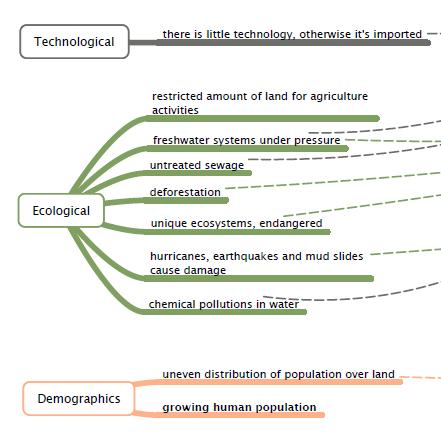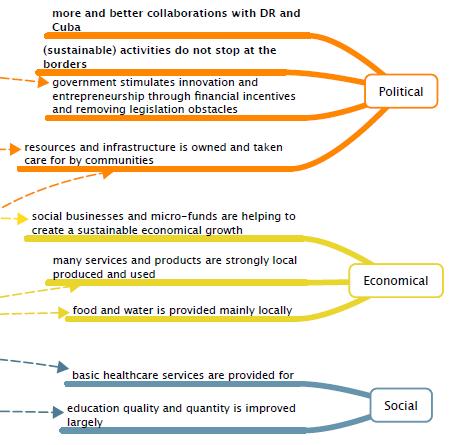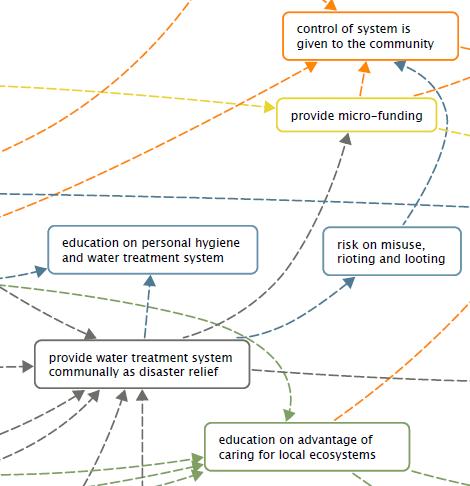The ‘Algae Connects’ Project
 A common thread in the Turning Ideas into Reality and Making a Living with BID conference calls was the need for more opportunities to do bio-inspired design. Janet Kübler suggested that the BID Community participate in the 2011 International Algae Competition which had the goal of developing “… an open source collaboratory that expands and shares a vision for algae in our future with design ideas for algae production landscapes, sustainable and affordable algae production systems”. Although the competition had a flavor of bio-utilization, the Algae Landscape Design track provided an opportunity to design a system that could incorporate ecological concepts and be inspired by the Life’s Principles.
A common thread in the Turning Ideas into Reality and Making a Living with BID conference calls was the need for more opportunities to do bio-inspired design. Janet Kübler suggested that the BID Community participate in the 2011 International Algae Competition which had the goal of developing “… an open source collaboratory that expands and shares a vision for algae in our future with design ideas for algae production landscapes, sustainable and affordable algae production systems”. Although the competition had a flavor of bio-utilization, the Algae Landscape Design track provided an opportunity to design a system that could incorporate ecological concepts and be inspired by the Life’s Principles.
An international team representing a wide range of skills including biology, design and engineering held their first official meeting on May 27th and agreed to submit an entry to the competition that had two main goals:
- develop a novel and useful bio-inspired (rather than biological) design involving algae that would demonstrate the value of biomimicry
- provide team members the opportunity to practice bio-inspired design
Although three of the team members live in Toronto, the team decided to meet virtually so that all team members could participate on an equal footing. Janet offered access to a web conferencing system that provided audio, chat, whiteboard, presentation and shared web browsing capabilities. The team initially held bi-weekly conference calls that lasted from one to two hours then switched to weekly calls on August 16th.
The team decided to take a problem-driven approach: how could algae make a positive impact in highly constrained environments. Early on, the team focused on disaster relief situations and their aftermath, using Haiti as a context to ground our research. Fil Salustri introduced the team to “Design for Social Business”, a model proposed by Muhammad Yunus to address social issues in developing countries that are poorly served by traditional business. Rather than meeting the acute needs created by a disaster, the team emphasized stabilizing and then growing the community.
The team wanted to deliver a systems solution. Systems are in a state of dynamic balance, constantly evolving and adapting. ‘Fixing problems’ in isolation can have unintended consequences at the systems level. A better approach is to identify ways to influence the system, using concepts such as Meadows’ Leverage Points: Places to Intervene in a System. We explored an approach that supports systems thinking. The diagrams are sections of the full roadmap.
- define the current state of the system (negative and positive aspects)
-

- describe a more desirable future state of the system
-

- backcast from future state to the current state, identifying barriers and ways of overcoming these barriers
- develop a roadmap of linked interventions that facilitate the transition from the current to the future state
-

- translate the interventions into specific design problems/solutions involving algae
Creating the roadmap was a key milestone in the project, bringing together the current state, interventions and future state into a single diagram. It supported the goal of showing how an algae-based technology could fit into and enhance the social, economic and environmental landscape while evolving over time. It allowed the team to visually identify ‘hot spots’ – clusters of interventions and highly connected future states. The team identified cleaning and purifying water as a means of delivering a wide range of benefits, including local food production.
After much discussion, the team decided to use Prezi as the platform for the competition entry. Prezi can be used to create highly visual and dynamic presentations. An important feature is support for near-simultaneous concurrent editing by up to ten people. This proved very useful in the last stages of the project as the changes were coming fast and furious! Dropbox was used to share files and documents.
Team members demonstrated a high degree of commitment to the project, in spite of the challenges of communicating electronically. The regular conference calls helped maintain focus. Small things like author thumbnails in forums helped personalize communication. Forums proved to be a useful method of collecting information but it quickly became difficult to access the information when required. One recommendation was to use Prezi as a virtual ‘project wall’, both to visually capture the state of the project as well as supporting group brainstorming. Future projects will test Google+ Hangouts as a scalable web conferencing system that supports up to 10 video streams. Being able to see who is speaking should help maintain energy levels during long calls.
The team incorporated ideas from the Life’s Principles, ecological succession (Ecosystem Recovery and Resilience to Large Disturbances) and Integrated Multitrophic Aquaculture. However, the team did not explicitly use the biomimicry tools or methods, relying instead on design methods such as random combinations and a morphological matrix or developing new methods on the fly. The shifting course of the project made project planning difficult and left some team members unsure how they could best contribute. The BID Toolkit project was initiated after the competition to help designers incorporate appropriate process into biomimetic design without stifling creativity. ‘Time-boxing’ the major phases of the project would have helped ensure that each received sufficient resources.
Inter-disciplinary design brings a wide range of interests, skills and knowledge to the already complex challenge of creative design. It takes time for a team to ‘gel’: team members need to develop a common language and a sense of where they can best contribute. Working with team members up front to determine their strengths could have helped increase productivity.
The Algae Competition gave many on the team their first opportunity to practice bio-inspired design outside of a workshop or classroom setting. Observing the progress of the project and the team dynamics helped all of us gain a better appreciation of the challenges and will provide ideas for future BID Community projects. Time will tell how well 'Algae Connects' rates in comparison with the other entrants to the competition.
Image Credits:
- Tree in Test Tube: © INFINITY - Fotolia.com
- Algae Competition roadmap: Mike Westdijk
Mike Westdijk, Karen Verbeek, Fil Salustri, Damian Rogers, Ernst-Jan Mul, Kamelia Miteva, Janet Kübler and Norbert Hoeller
